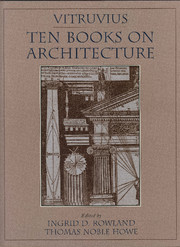INTRODUCTION
Published online by Cambridge University Press: 18 December 2014
Summary
Marcus Vitruvius Pollio wrote his ten books on architecture in the first decade of the Pax Augusta, c. 30–20 b.c. This was a decade of renewed peace and prosperity that followed some two or three generations of brutal turmoil and civil war, starting with the conflict between Marius and Sulla in the 90s b.c. (or the “reforms” of the Gracchi in the 130s) and culminating in the civil war of the second triumvirate and the defeat of Marc Antony and Cleopatra at Actium in 31. It was a time of renewed building, both architectural and cultural, a time endowed with a confidence that the world was being remade anew. It was also a time when an educated person seeking to visualize this new world order could draw on a rich international Hellenistic and Italic culture of science, technology, literature, arts, and architecture.
Literary Genre
The Libri Decem are a hybrid type of literature that was common in the last century of the Republic: a technical handbook with literary ambitions. As a loosely defined type, these books tend to be rather idiosyncratic and original because the approach tends to force the authors to combine topics in unusual ways.
Duality of style is necessarily inherent in these specialized books. Rhetorical language was focused on the prefaces, or excursus, and technical sections relied on more prosaic language.
The readership of these books was intended to be fairly wide and almost certainly did extend well beyond the “experts” or “professionals” in the particular field. Augustus was fond of books of precepts and would copy books he thought to be useful and send them to members of his household or to officers and to provincial officials. He would commonly read such books to assemblies and on one occasion read sections of Rutilius's De Modo Aedificiorum to the Senate. It is debatable whether Vitruvius's work was ever the “handbook” of Augustan architecture, but he certainly must have hoped it would become so.
- Type
- Chapter
- Information
- Vitruvius: 'Ten Books on Architecture' , pp. 1 - 18Publisher: Cambridge University PressPrint publication year: 1999



